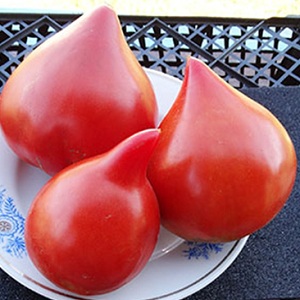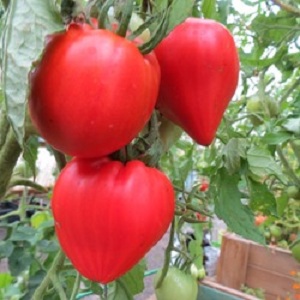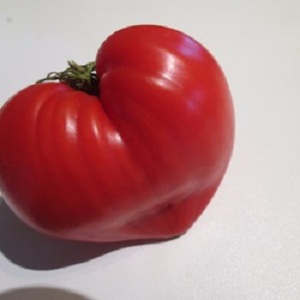German variety of tomato "Vater Rhine" - ideal for making salads, juice, ketchup and various sauces
The Vater Rhine tomato is a product of the selective work of German biologists. It is known for its unsurpassed balanced taste, which combines moderate sweetness and pleasant sourness. Today you will find out why gardeners love this variety, how to achieve high yields with the help of agrotechnical techniques and protect plants from diseases and insect pests.
The content of the article
Description of the variety
The German tomato variety Vater Rhein (original name Vater Rhein, literally "Father Rhein") is included in the Gene Bank of the German Institute of Plants. Leibniz. The State Register of Selective Achievements of Russia is absent.
The seeds are distributed mainly by amateur gardeners. On the forums, information is often found about the inconsistency of the characteristics declared by the manufacturer. The reason for this is re-grading or non-compliance with the rules of agricultural technology.
Tomatoes are grown in greenhouse conditions in temperate regions and outdoors in the south of the country.
In the photo - Vater Rhein tomatoes.

Distinctive features
Features of culture:
- semi-determinant bushes up to 1.5 m high;
- leafiness is scarce, leaves are thin, drooping, green;
- there are few stepsons;
- 3–5 ovaries are formed on the fruit cluster;
- ripening period - 95-105 days;
- requires the formation of 2-3 stems;
- excellent keeping quality;
- the level of transportation is average;
- the purpose in cooking is universal.
Fruit characteristics:
- the shape is original, slightly ribbed, resembles a heart with an elongated nose;
- the average weight of tomatoes is 200-300 g, the maximum weight is 1 kg;
- the color is red, without a dark spot;
- the pulp is sweet and sour, sugary and fleshy;
- pronounced tomato aroma;
- the skin is thin, glossy, smooth;
- when cut, the pulp retains its shape, contains a minimum amount of seeds;
- seed chambers about six, small in size.
Important! To achieve the declared characteristics, tomatoes are left to fully ripen on the bushes.
The exact information on the yield of the variety is not provided. According to the observations of farmers, from one bush, on average, it is possible to collect up to 5 kg, from 1 m² - 15–20 kg of selected fruits, subject to proper agricultural technology.
Agrotechnics of tomatoes
The Vater Rein variety is distinguished by its demands on lighting and nutrition. Otherwise, caring for the plant is no different from the cultivation of other tomatoes and provides for a moderate watering, fertilizing, loosening the earth and weeding weeds.
Soil preparation and sowing seeds
The culture is grown through seedlings. Sowing begins 55-60 days before planting in the ground. The soil is prepared independently from a mixture of black soil, peat and sand in a ratio of 1: 1: 1. 40 g of superphosphate is added to a bucket of substrate, then it is disinfected in the oven, steamed, or with a concentrated solution of potassium permanganate.
The seeds are soaked in a slightly pink solution of potassium permanganate for 30–40 minutes and washed with running water. Some gardeners recommend pre-germinating the grains. To do this, they are laid out in gauze, folded in 2-3 layers, and poured with water. The cloth is placed in a bowl, covered with cling film and left in a warm place for 24 hours. The seeds will "wake up" in 3-5 days at a temperature of +23 ° С.
The seedling boxes are filled with moist soil and the seeds are sown to a depth of 1.5–2 cm at a distance of 2 cm from each other. Stretch a film on top or put glass on top. Sprouts appear at an air temperature of +22 ° С in 4–6 days.
Growing seedlings
After the seeds hatch, the cover is removed, and the boxes are taken out to a sunny place. The air temperature should be +15 ° С. This is necessary to strengthen the protective forces of the seedlings. After a week, the air temperature is gradually increased to +24 ° C.
Water sparingly, as the top layer dries, using a spray bottle. An excess of moisture leads to decay of the root system.
Picking into individual pots is carried out after the appearance of 3-4 leaves.
Gardeners note that Vater Rhine seedlings look weak compared to other tomato seedlings and need sufficient light. With a lack of sunlight, fluorescent lamps are used. The norm of daylight hours is 16 hours.
Top dressing with ready-made fertilizers "Agricola", "Radiance", "Effecton" helps to strengthen the seedlings.
Landing
A place for planting seedlings is chosen in the southern side of the site. This applies to both closed and open ground.
Before moving the seedlings to a permanent place, it is advisable to make sure that there is no threat of night frosts. Soil temperature should be at least +16 ° С.
The land on the site is prepared in the fall: they dig up, remove weeds with roots, fertilize with humus (1 bucket of 10 liters per 1 m²). In the spring, the soil is loosened and humus is added (10 liters per 1 m²).
Tomatoes grow faster in the area where cabbage, onions, beans or peas were previously cultivated. It is not recommended to use the land in which eggplants, tomatoes, bell peppers grew. This is the main principle of crop rotation.
Seedlings are planted from early to late May. Planting density - 3-4 bushes per 1 m². The arrangement of the bushes is 30 × 40 cm.
The wells are dug to a depth of 20 cm and filled with boiling water. Seedlings are watered abundantly with warm water and planted in holes. Wooden stakes are dug in nearby, to which bushes are tied up in a week.
Care

Care rules:
- Plants stepchild and form 2-3 stems for abundant fruiting. Formation in 1 stem allows you to grow giant fruits weighing up to 1 kg.
- To strengthen the bushes, hilling is carried out - 2-3 times during the growing season.
- Plants are tied every 14–20 days.
- Watering is moderate - 1-2 times a week, 1 liter of rain or settled water under each bush in the evening.
- Loose and weed every week.
Council. Cover the soil with mulch (agrofibre, sawdust, pine needles, hay) to prevent weed growth and moisture retention.
Tomatoes are fed 3-4 times during the growing season:
- The first feeding - mineral-organic, 10 days after planting seedlings (10 g of superphosphate, 10 l of mullein solution).
- Subsequent dressings - with mineral compositions every two weeks (10 g of diammofoska per 10 liters of water). The solution is sufficient for watering 1 m².
Ready-made mineral complexes - "Kemira lux", "Tsitovit", "Solution" - compensate for the lack of phosphorus, potassium, zinc, magnesium, manganese, accelerate the ripening of tomatoes. They are used once every 14 days for foliar dressing.
Diseases and pests
Tomato Vater Rhine rarely suffers from viral diseases (verticillosis and fusarium), but predisposed to late blight and top rot.
Signs of late blight infection:
- brown spots with a gray tint on stems and leaves;
- white bloom on the back of the leaves;
- deformation of tomatoes.
Control methods:
- prevention (soil cultivation with copper sulfate, moisture control, timely feeding with phosphorus and potassium);
- spraying with "Ridomil", "Quadris", "Acrobat", "Agat", "Fundazol".
Top rot signs:
- depressed spots on the top of the fruit of a green hue, which, as the disease progresses, turn brown and then black;
- cracks in the skin;
- puckering of tomatoes;
- the pulp begins to rot.
Control methods:
- preventive disinfection of seeds with potassium permanganate;
- introduction of chalk into the soil (50 g per 1 m²);
- foliar top dressing with potassium (10 g of calcium nitrate per 10 liters of water, 500 ml per 10 m²);
- mulching with nettles, straw, white agrofibre;
- ventilation of greenhouses.
Tomatoes are a favorite treat aphids, wireworm, bear and whitefly... Insecticides "Thunder", "Force", "Fitoverm", "Epin" help to fight pests.
Folk remedies are no less effective:
- Pour 100 g of onion husks with 1 liter of warm water. Insist for 10-12 hours and mix in 25 ml of liquid soap. Irrigate the bushes once every 7 days.
- Boil 3 kg of fresh wormwood in 10 liters of water for 30 minutes. Refrigerate and spray tomatoes once every 7 days.
- Mix 150 g of hot pepper, 10 l of water, 400 ml of vinegar. To combat the bear, insist the mixture for 24 hours and pour 0.5 liters into the mink.
The nuances of growing in open ground and in a greenhouse
The Vater Rein variety is generally not capricious, responds with gratitude to feeding. Gardeners are advised to fertilize tomatoes once every seven days. Slender bushes do not go into fattening compared to highly leafy tomatoes.
When cultivating in a greenhouse, the moisture level must be controlled. Excess leads to late blight and brown spot.
The culture reacts painfully to a sharp drop in temperature, therefore, in the middle lane, tomatoes are recommended to be grown in greenhouses. In the south, in the open field, it is possible to reduce the yield during drought. In such cases, the frequency of watering is increased.
Harvesting and application of the crop
2–2.5 weeks before harvesting, all flower clusters and ovaries are cut off from the bushes. Tomatoes are harvested before the onset of cold weather due to the culture's predisposition to putrefactive lesions.
Fully ripe tomatoes have an amazingly rich flavor and aroma. Suitable for fresh consumption, making pasta, juice, sauce, lecho and adjika.
To extend the shelf life, the fruits are harvested at the stage of blanche ripeness (brown).
Advantages and disadvantages
Variety advantages:
- wonderful rich taste;
- excellent presentation;
- high productivity;
- universal purpose;
- a small amount of seeds.
Disadvantages:
- intolerance to heat and cold;
- the need for pinching and garter.
Reviews
Fater Rhine tomatoes leave rave reviews, first of all, because of their excellent taste.
Irina, Bryansk: «I planted the tomatoes in the greenhouse, in the best place. I was afraid that the frail seedlings would not survive after the transfer. But in fact, the variety turned out to be the most productive of all. Fruits as in the picture: bright, liquid, with a long tail. I watered it once a week, fed it with ready-made Kemir fertilizer. I filmed fully ripe tomatoes. These are the most delicious. "
Anatoly, Vyksa: “The most delicious tomatoes in my garden are Vater Rein. An interesting heart-shaped shape, sweet, aromatic pulp, relative unpretentiousness in care - that's why I love them so much. I grow in a film greenhouse, I try not to overflow and fertilize on time. I take off the fruits before the cold weather. "
Conclusion
The mid-early variety Vater Rhine feels great indoors and outdoors, subject to the rules of agricultural technology: moderate watering, timely complex fertilizing, pinching and forming bushes in 2-3 stems. When grown in one stem, farmers manage to get giant fruits weighing about 1 kg. The culture is highly valued for its excellent taste, high yield and interesting fruit shape.